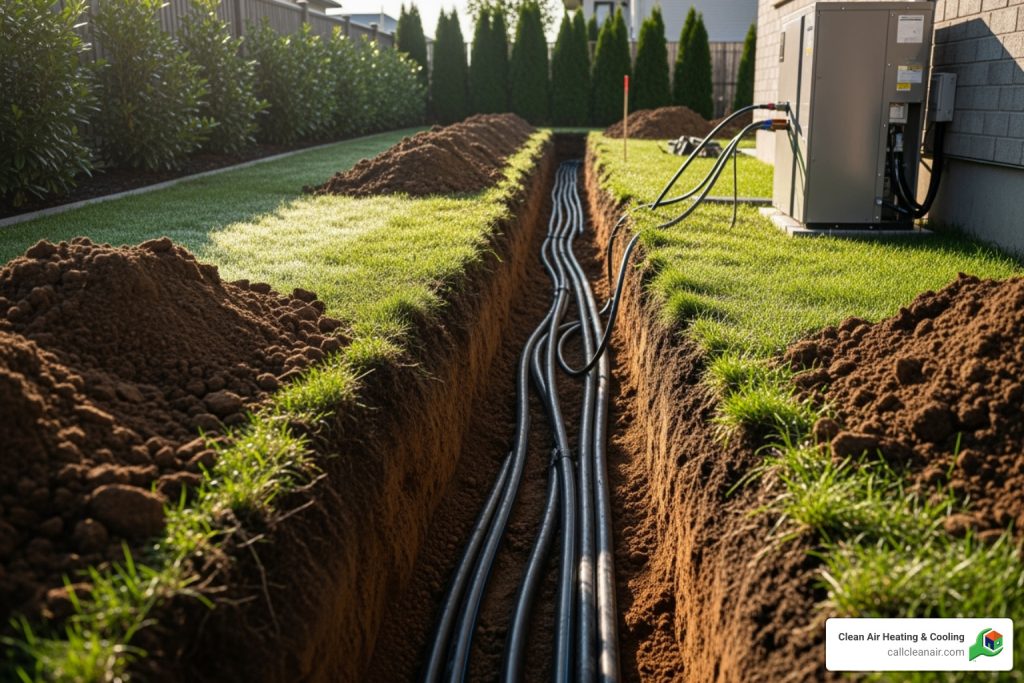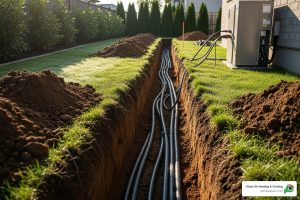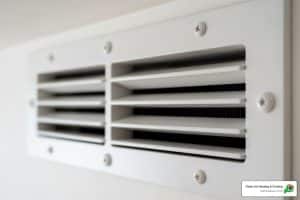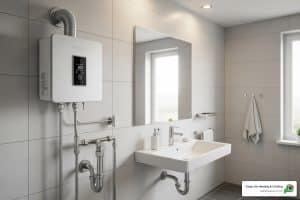Why Understanding Geothermal System Costs Matters for Your Home
A closed loop geothermal system cost typically ranges from $15,000 to $38,000 for an average-sized home. Several key factors influence your final investment:
- System Type: Horizontal loops ($15,000-$34,000), Vertical loops ($20,000-$38,000), Pond/lake loops ($10,000-$32,000)
- Home Size: Larger homes require more capacity, increasing costs by $2,500-$8,000 per ton.
- Installation Complexity: Drilling depth, soil conditions, and property access affect labor expenses.
- Equipment Quality: Heat pump efficiency ratings (COP/EER) influence upfront and operational costs.
- Additional Work: Ductwork modifications, electrical upgrades, and permits add to total expenses.
Many homeowners in Northwest Washington struggle with high energy bills and inconsistent home comfort. Geothermal systems offer a powerful solution by using the earth’s stable underground temperature (around 50-60°F year-round) to efficiently heat and cool your home.
While the upfront investment is higher than traditional HVAC, geothermal systems can cut heating and cooling costs by 25% to 65%. The underground loops last 50+ years, and the heat pumps run for 20-25 years. Factoring in a 30% federal tax credit and long-term energy savings makes the investment highly attractive.
This guide breaks down every aspect of closed-loop geothermal costs, from installation to long-term savings. I’m Colin Matei, Owner of Clean Air Heating & Cooling. I’ve helped countless homeowners in Whatcom, Skagit, and Snohomish counties evaluate the costs and make the best choice for their home’s comfort and efficiency.
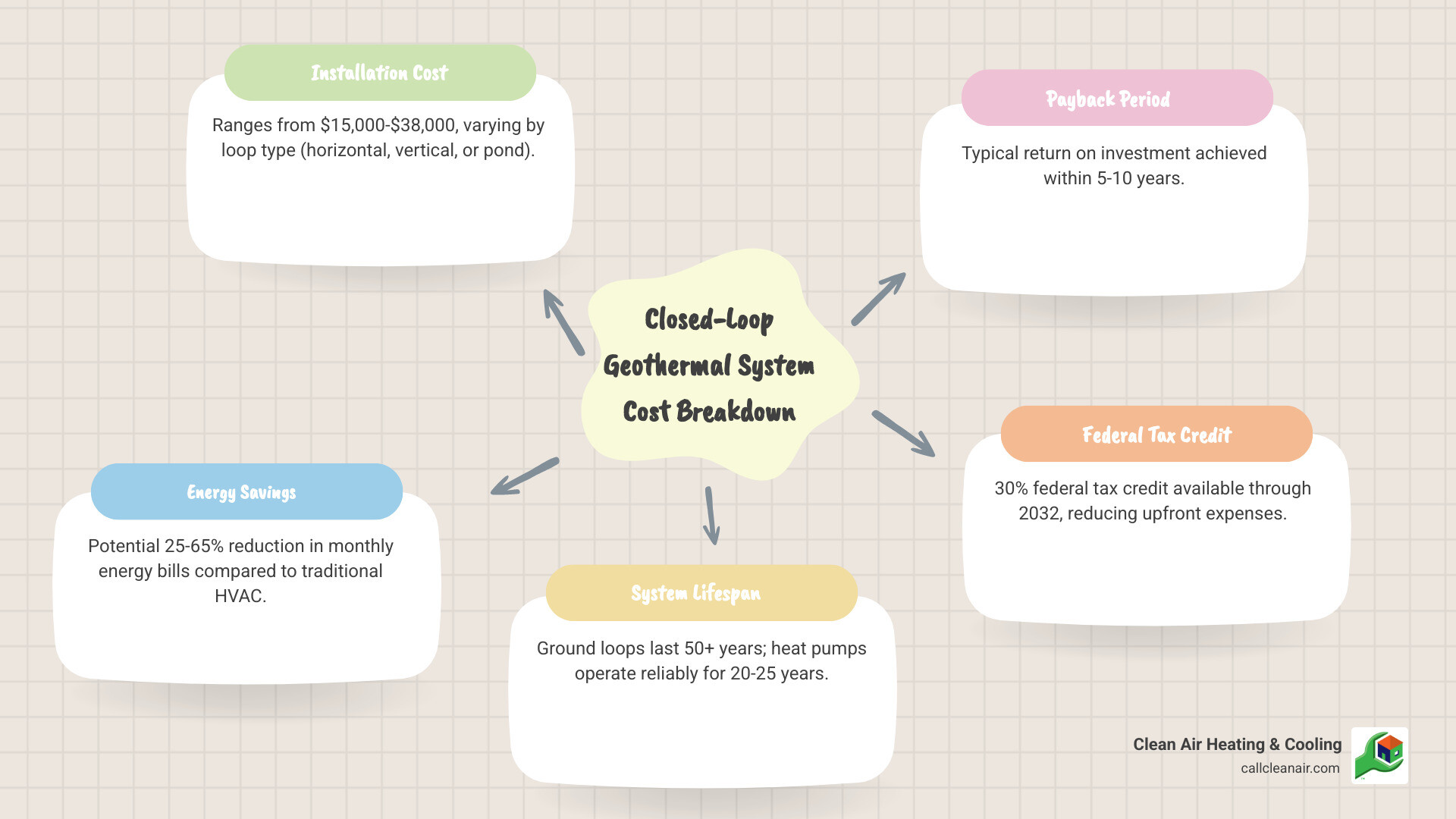
Key terms made easy:
Understanding Closed-Loop Geothermal Systems
A closed-loop geothermal system provides comfort by borrowing from the steady temperature deep underground. Here in Northwest Washington, the earth stays at a constant 50-60°F year-round. Geothermal systems use this stable temperature for highly efficient heating and cooling through a process called geothermal heat exchange.
A network of durable pipes, called a ground loop, is buried in your yard. A water-based solution circulates through this loop, absorbing heat from the earth in the winter and carrying it to an indoor geothermal heat pump. The pump concentrates this heat and distributes it through your home. In the summer, the process reverses: the system pulls heat from your home and transfers it back into the cooler earth.
A closed-loop system has three main components:
- The Ground Loop: The underground pipe network that exchanges heat with the earth.
- The Geothermal Heat Pump: The indoor unit that moves heat between the ground loop and your home. Learn more here: What are Heat Pumps? How Do They Work?.
- The Distribution System: Your home’s ductwork, which circulates the conditioned air.
Because the fluid is in a sealed, self-contained loop, there is no water waste, and the system is protected from the elements, ensuring a long lifespan.
What Are the Different Types of Closed-Loop Systems?
Choosing the right ground loop is a key factor in your overall project cost. The best option depends on your property’s size, soil, and geography.
-
Horizontal Loops: Ideal for properties with ample space (0.25 to 0.75 acres). We dig trenches 6-10 feet deep to lay the pipes. This is often the most budget-friendly option as it avoids deep drilling.
-
Vertical Loops: Perfect for smaller yards or rocky terrain. We drill narrow boreholes 150-300 feet deep, giving the system a very small surface footprint. Costs are generally higher due to specialized drilling.
-
Pond or Lake Loops: A highly economical choice if you have a nearby body of water at least 8 feet deep. Coiled pipes are submerged in the water, which can sometimes lower installation costs compared to ground loops.
-
Slinky Loops: A variation of horizontal loops where pipes are coiled to fit more piping into a shorter trench. This is a good compromise for properties with limited, but not minimal, space.
Each loop type affects the final price. The U.S. Department of Energy provides more detail on these three types of closed loop geothermal systems.
The Complete Closed Loop Geothermal System Cost Breakdown
The total cost of a closed-loop geothermal system is a comprehensive investment in your home’s energy future. While it’s a significant upfront expense, it delivers substantial long-term returns.
The costs typically come from four main areas:
- Drilling and Excavation: This is often the largest expense, especially for vertical loops that require specialized deep drilling. Horizontal loop excavation is less costly but requires more land.
- Labor Costs: Skilled technicians are essential for ground assessment, loop installation, and connecting the indoor unit. Labor can account for a significant portion of the total project cost.
- Heat Pump Unit Price: The price of the indoor geothermal heat pump varies based on its size, efficiency, and features.
- Additional Components and Work: This includes piping, grout for boreholes, heat transfer fluid, and potential modifications to your home’s ductwork, electrical system, or permits.
The underground loop field installation can account for a large percentage of the total price, which is why looking at the heat pump cost alone is misleading. A professional assessment is the only way to get a precise, personalized quote.
Average Closed Loop Geothermal System Cost by Type
The underground loop design is a primary driver of the overall budget. Here’s a comparison for homeowners in Whatcom, Skagit, and Snohomish counties:
| Loop Type | Land/Water Requirement | Pros | Cons |
|---|---|---|---|
| Horizontal | 0.25 to 0.75 acres of open land; trenches 6-10 ft deep | Often more budget-friendly; Less invasive drilling than vertical | Requires significant land area; Can disrupt landscaping more |
| Vertical | Minimal land footprint; boreholes 150-300 ft deep | Ideal for limited space; Less landscape disruption; Consistent ground temp | Involves higher drilling expenses; Requires specialized equipment |
| Pond/Lake | Pond/lake at least 8 ft deep, 0.3-1.0 acre surface area | Potentially a very economical choice if water body is nearby; High efficiency | Requires a suitable water body; Permitting for water use may be complex |
Horizontal loops are a great choice for properties with open space, while vertical loops are the solution for smaller lots. Pond loops can offer exceptional value for properties with a suitable water body.
Closed-Loop vs. Open-Loop System Costs
While we focus on closed-loop systems, it’s useful to know the alternative. Open-loop systems draw water from a well, use it for heat exchange, and discharge it. They can have a lower initial cost if a suitable well exists but come with other considerations.
Open-loop systems require a reliable water source, may need more maintenance due to mineral buildup, and can be subject to water use regulations and permit fees. For these reasons, most homeowners in our area prefer closed-loop systems for their reliability, low maintenance, and peace of mind.
Key Factors That Influence Your Final Price Tag
Total costs are unique to every home. We design a custom solution based on your property and comfort needs, which is why the final price varies.
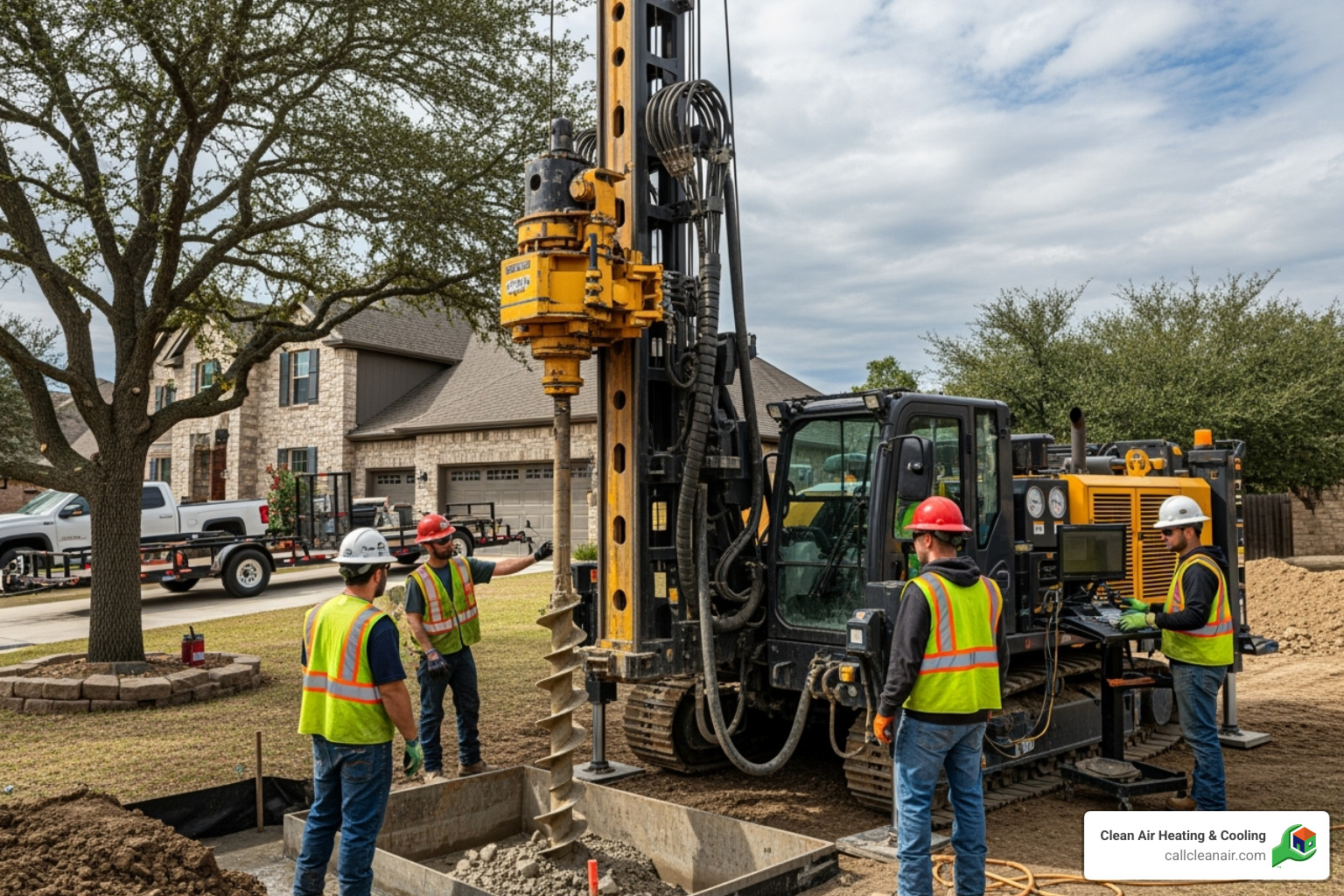
Key pricing factors include:
- System Sizing: We use a Manual J calculation to determine the exact heating and cooling capacity your home needs based on its size, insulation, windows, and layout. An improperly sized system is inefficient and costly.
- Home Insulation: A well-insulated home requires a smaller, less expensive system. We recommend improving your home’s thermal envelope (insulation and air sealing) before any new HVAC installation for maximum efficiency.
- Loop Length and Depth: A larger home or one with poor insulation needs a larger loop field (more piping) to meet its heating and cooling demands, which increases material and labor costs.
- Heat Pump Efficiency: Geothermal heat pumps are rated by COP (heating) and EER (cooling). A higher-rated unit costs more upfront but delivers greater long-term energy savings.
- Ductwork: If your existing ductwork is undersized, leaky, or non-existent, modifications or a new installation will be an additional cost.
- Electrical Upgrades: Older homes may need an electrical panel upgrade to accommodate the dedicated circuit required for a geothermal system.
How Soil and Geology Impact Your Closed Loop Geothermal System Cost
The ground beneath your home is a critical factor in both system performance and installation cost.
- Soil Composition and Moisture: Dense, moist clay soil is excellent for heat transfer. Sandy, dry soil is less conductive and may require a larger loop field to achieve the same performance, increasing the total cost.
- Thermal Conductivity: We can test your soil’s ability to transfer heat. Low conductivity may require a modified loop design with more piping.
- Rocky Terrain vs. Soft Soil: Drilling through bedrock or excavating rocky ground is more difficult, time-consuming, and expensive than working with soft soil. It requires specialized equipment and can impact the project budget.
A professional site assessment is crucial to understand these geological factors and provide an accurate estimate.
Long-Term Value: Savings, Lifespan, and Payback
While the initial price tag is significant, the long-term value is where this investment truly shines. It’s a decision that pays dividends in savings and comfort for decades.

Geothermal systems don’t create heat; they move it. This efficiency leads to incredible long-term benefits:
- Operational Cost Savings: Expect to save 25% to 65% on your heating and cooling costs compared to conventional systems, according to the U.S. Department of Energy.
- Exceptional Lifespan: The indoor heat pump unit lasts 20 to 25 years, nearly double that of a typical furnace or AC. The underground loop field is even more impressive, engineered to last 50 to 100 years.
- Fast Payback Period: With significant energy savings and available incentives, most homeowners see their geothermal investment pay for itself in just 5 to 10 years.
Operational Savings and Ongoing Costs
After installation, the financial benefits of your geothermal system become clear. Geothermal systems are 25% to 65% cheaper to operate than conventional HVAC. Those monthly savings add up quickly, proving the initial investment was a wise choice.
Maintenance needs are also remarkably low. The system has fewer moving parts, and the main components are protected underground. We recommend an annual inspection (typically $100-$250) to check fluid levels, electrical connections, and change filters to keep it running efficiently. Learn more about The Importance of Regular Heat Pump Maintenance.
Potential repair costs are infrequent and typically minor, such as fan or thermostat replacements. The ongoing operational savings far outweigh the minimal maintenance and repair expenses, making geothermal one of the smartest financial decisions for your home.
Maximizing Your Investment with Incentives and Benefits
The upfront cost can be significantly reduced by taking advantage of available incentives. These programs make clean energy more accessible and shorten your payback period.
Key financial aids include:
- Federal Tax Credits: The largest incentive available.
- State and Local Rebates: Programs specific to Washington can add more savings.
- Utility Programs: Local utilities often offer their own rebates and low-interest financing.
- Energy-Efficient Mortgages: These can bundle the system cost into your home loan.
At Clean Air Heating & Cooling, we help customers steer these programs. Learn more about our assistance with Utility Rebates and Financing.
Government Incentives and Tax Credits
The Federal Residential Clean Energy Credit is a game-changer, providing a 30% tax credit for qualifying geothermal installations through 2032. According to ENERGY STAR, the credit applies to the total cost, including labor, with no cap. To qualify, the system must meet Energy Star requirements and be installed in your primary U.S. residence.
Washington state incentives can also reduce your net cost. We recommend checking for the latest local programs at the DSIRE database: state incentives for renewable energy.
Core Benefits of a Closed-Loop System
Beyond financial savings, geothermal systems offer profound benefits for your home and the environment.
- Reduced Carbon Footprint: Geothermal systems don’t burn fossil fuels and can cut greenhouse gas emissions by up to 65% compared to traditional HVAC.
- Quiet Operation: With no noisy outdoor fan, these systems operate as quietly as a refrigerator.
- System Durability: The underground loops last 50-100 years, and the indoor unit lasts 20-25 years, ensuring decades of reliable service.
- Improved Home Comfort: Enjoy consistent, even temperatures without hot or cold spots. Many systems also provide “free” hot water by capturing excess heat.
- Safety: With no on-site combustion, there is no risk of carbon monoxide or gas leaks.
Frequently Asked Questions about Geothermal Costs
Homeowners considering geothermal often have similar questions. Here are answers to the most common ones we hear.
How long does a geothermal system last?
Geothermal systems are built for longevity, which is a key part of their value.
- The indoor heat pump unit typically lasts 20 to 25 years, which is nearly double the 10-15 year lifespan of conventional furnaces and air conditioners.
- The underground loop field is even more durable, designed to last 50 to 100 years. The high-density polyethylene piping is resistant to corrosion and often comes with a 50+ year warranty.
The most expensive part of the installation—the loop field—is a generational investment that will likely outlast your ownership of the home.
Is my property suitable for a geothermal system?
The answer is almost always yes, as there is a geothermal solution for nearly any property.
- Larger yards are ideal for horizontal loops, which are often the most economical choice.
- Smaller lots or rocky terrain are perfect for vertical loops, which have a minimal surface footprint.
- Properties with a pond or lake can use a highly cost-effective pond loop.
Geothermal can be installed in both new construction and existing homes. While installation during new construction can be less expensive, retrofitting is very common and effective. A professional site assessment is the best way to determine the ideal system for your specific property, soil conditions, and budget.
What is the typical payback period for a geothermal system?
The payback period is the time it takes for your energy savings to offset the initial investment. According to the U.S. Department of Energy, most geothermal systems pay for themselves in 5 to 10 years.
Several factors influence your specific payback timeline:
- Initial installation cost (after incentives)
- Your home’s energy consumption and insulation levels
- Local utility rates
- Available tax credits and rebates
The current 30% federal tax credit significantly shortens this payback period. We can provide a personalized payback estimate during a consultation.
Is a Closed-Loop Geothermal System Right for You?
After breaking down the costs, benefits, and long-term savings, the final question is whether it’s the right choice for you. A geothermal system is a long-term investment in your home’s comfort, financial future, and environmental stewardship.
Consider if these benefits align with your goals:
- Long-Term Financial Savings: The system pays for itself in 5-10 years through 25-65% lower energy bills, then continues to save you money for decades.
- Environmental Responsibility: You can cut your home’s greenhouse gas emissions by up to 65% by using the earth’s renewable energy.
- Superior Comfort and Quiet: Enjoy consistent, even temperatures year-round and the peace of a system with no noisy outdoor unit.
At Clean Air Heating & Cooling, we’ve helped hundreds of homeowners in Whatcom, Skagit, and Snohomish counties make the switch to geothermal. Our expertise is reflected in our 25% utility savings guarantee and over 480 5-star Google reviews.
Most properties can accommodate a geothermal system, and with incentives and financing, the investment is often more manageable than expected. Our goal is to provide honest information to help you determine if geothermal is the right fit for your home and budget.
If you’re ready to explore what a geothermal system could mean for your property, let’s talk. Get a professional estimate for your heat pump installation, and we’ll provide a clear breakdown of the costs, savings, and process. No pressure, just expert answers to help you invest with confidence.

